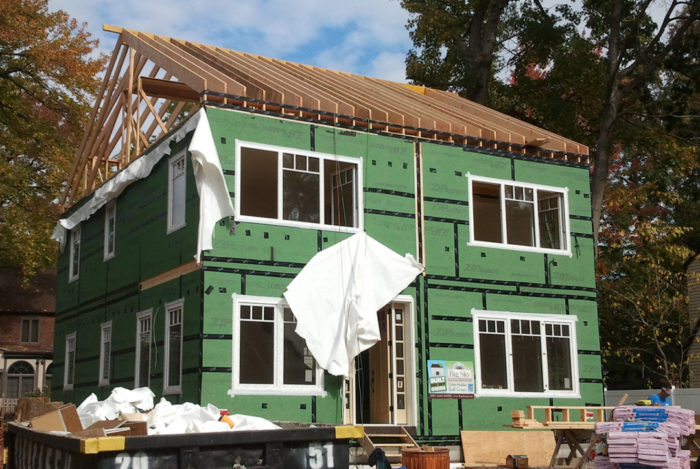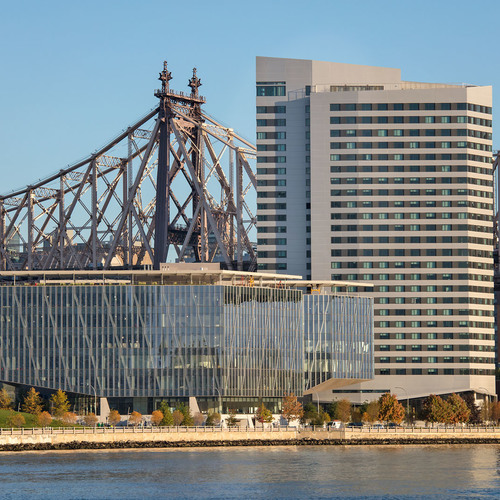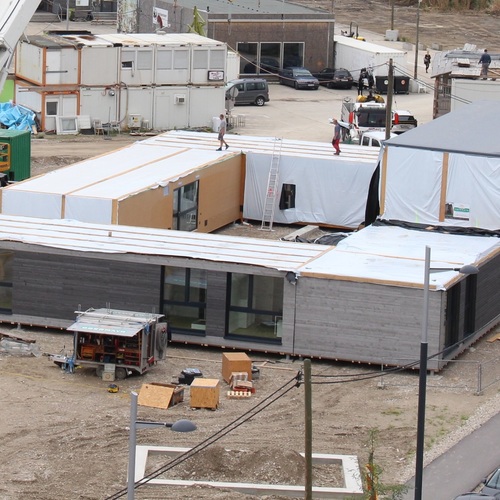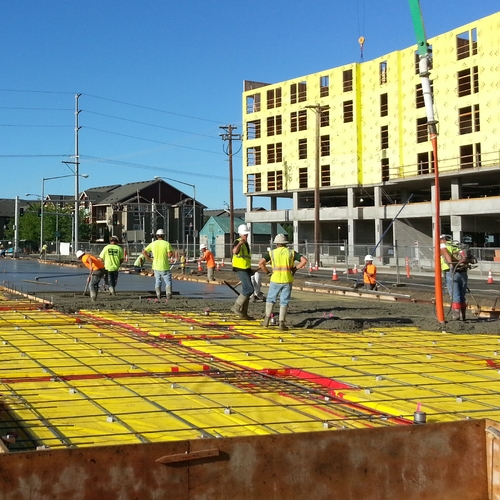Image Credit: Len Moskowitz
Image Credit: Len Moskowitz A rendering shows the finished project. The 2,300-square-foot house has a full basement and will have a conditioned attic. Its owners hope to move in by the first of the year.
Image Credit: Rendering: Noam Eisen/Van Bemmelen Architecture LLC A house in four parts: Four factory-built modules are stacked together to create the 2,300-square-foot house. The builder then framed the roof conventionally, added a porch, and took care of some interior details.
Image Credit: Len Moskowitz
The first house to win Passivhaus certification in New Jersey could turn out to be a modular home under construction in Teaneck.
The four modular units that make up the 2,300-square-foot home were constructed by Westchester Modular Homes and craned into place in mid-October, according to an article published in The Record. Big Sky Custom Homes, the general contractor, is now framing the roof, building a porch, and taking care of other details. The owners, Lenny Moskowitz and his wife Deborah Teplow, hope to move in by early January.
“It’s a long story,” Moskowitz said by telephone of their decision to build to the Passivhaus standard. “The short version is we wanted serious energy efficiency. I had gone through the exercise of looking at geothermal heating and other ways of climate control for the house and they all ended up being very expensive unless you made the house itself very tight and very well insulated. So we ended up going for Passivhaus.”
Because it’s not complete, the house has yet to pass a key hurdle for certification: confirmation it meets the airtightness requirement of 0.6 air changes per hour at a pressure difference of 50 pascals. But if it clears that, Moskowitz says, they’ll seek certification through the Passive House Institute U.S.
Open to all ideas
Neither the owners nor architect Malka van Bemmelen was wedded to the idea of using modular construction at the start of the project. But as they began soliciting bids, that approach began to look promising.
They talked to five builders, two who build with structural insulated panels (SIPs) and two who use modular construction. A fifth, who would have built the house conventionally, was ruled out early in the process. Although he had the reputation of being a meticulous builder, Moskowitz said, he would have taken too long to complete the work.
SIP construction was competitive “to a point,” he added, but in the end they settled on Westchester Modular Homes, which built the units at its Wingdale, N.Y., factory.
Moskowitz said he knows of only one or two other modular home companies that are willing to build to the Passivhaus standard, but he added that this project could help expand options for buyers in the future.
“For now, if we can certify and we can spread the good word and cultivate a modular factory that will do this on the East Coast, I think that would be great,” he said. “We want to spread the word.”
Double-stud walls
Exterior walls are a total of 9 1/4 inches thick and consist of two 2×4 framed walls built on common 2×10 top and bottom plates. Wall cavities are insulated with dense-packed cellulose, and the outside of the house will be covered in 2 inches of expanded polystyrene (EPS) rigid insulation for a total of R-41.
The exterior foam was necessary to get the required R-value for the energy modeling, but they could have skipped that with a thicker wall and more cavity insulation. Moskowitz said that because of a misunderstanding the factory originally said it would be unable to building anything thicker than 9 1/2 in. As it turns out, they could have built the walls on a 12-in. plate and skipped the foam. Should another buyer want a Passivhaus modular, that’s what Westchester could do.
Footings and foundation walls are insulated with 4 inches of EPS foam, with a 2×6 framed wall filled with fiberglass batts on the foundation interior (total of R-36). There are 8 inches of EPS installed beneath the basement slab (R-30). The 2×12 framed roof will be insulated with closed-cell polyurethane foam for an R-value of about R-67.
Other features include:
- A rooftop photovoltaic array with a capacity of between 8 kW and 10 kW.
- Heating and cooling provided by two Mitsubishi Mr. Slim ductless minisplits, each with a capacity of 12,000 BTU/h. One head will go on the first floor, and the other on the second floor.
- Domestic hot water will be produced by a 50-gallon GE Geospring heat-pump water heater.
- Triple-glazed windows made by Schüco.
- Hardiplank fiber-cement cladding.
- A 500-gallon cistern that holds rainwater for use in the 0.8 gallon-per-flush toilets.
Moskowitz says the four modules making up the core of the house cost about $180,000. When windows, foundation, the roof and other costs are added, he expects the project to total between $375,000 and $385,000.
With the PV system installed, the all-electric house could become energy self-sufficient and relieve Moskowitz and Teplow of all utility bills. Still, there are parts of the Passivhaus approach that Moskowitz could live without.
“It’s not a perfect spec,” he said. “Why, when my foundation goes down to 50-degree constant year-round in temperatures, why do I have to insulate it as though it were above ground? That doesn’t make a lot of sense, I don’t think.”
Moskowitz has set up a Facebook page for those who’d like to learn more: Passive House NJ.
Weekly Newsletter
Get building science and energy efficiency advice, plus special offers, in your inbox.
















9 Comments
Certification
I completely understand the motivation to build a energy efficient house, and the usefulness of standards like Passive house as design guidelines, but why seek certification? Especially if it makes you include things that you don't think are a good idea.
Re: Certification
Great question! We're so keen on certification for several reasons:
1. It validates the performance of the house. It's not enough to meet a building specification. We need to answer the question, "Does it work?" Certification validates that our house meets a standard designed to deliver performance results.
2. Certification documents our commitment to a standard that offers an innovative solution to the energy-efficiency challenge.
3. Certification allows us to add our voices to a whole community and demonstrates our allegiance to a shared vision for energy efficiency. The challenges we face are the challenges of individuals and the nation. Although we may quibble with certain details of the required standard, we believe it is one of the best models to adopt right now and are proud to be part of the pioneering effort to popularize it.
Re: Certification + Project costs
Len,
Wonderful answers to the certification question - I could not agree more! Congratulations to you and Deborah for being early adopters of the standard in US. We are trying to follow as well and have a duplex house design, alas, predicted construction and soft costs are a bit more than we expected. We may seek an estimate from the modular factory. Would you mind sharing what is included in "other costs" that make up $385 total? (Is this the total cost for the house, or not?)
Thanks,
Lucyna
Project Costs
Going through our project spreadsheet, it includes our GC's fee; the cost of the four modules from Westchester Modular Homes, including the set cost; the cost of excavating, insulating and pouring the footings and foundation (including the cartage for dirt taken away from the site); insulating and pouring the slab; the cost of the Shuco windows and their shipping to the US; framing. insulating and shingling the roof; installing the Shuco windows in the attic and the basement; the HRV and its ducting; the two mini-splits; connecting the utilities (electricity, water and sanitary sewer); the plumbing and electrical hookup in the basement; buying and installing the bathroom fixtures and furnishings (shower doors, vanities, wall and floor tile); buying and installing the Ikea kitchen cabinets and our choice of appliances; flooring; excavating and building the front porch and the rear deck; installing the leaders & gutters; excavating and installing the rain cistern and drainage pit; installing the driveway and walkways; grading the site for drainage; and minimal landscaping.
It doesn't include the cost of designing the house, permits, storage of our belongings during construction, the PV array, or the cost of subdividing our property.
I'm certain that I've missed a few details, but that's most of it.
was CLT considered?
Congratulations on the commitment to build to passive haus standard! I am curious if during your design phase you were ever introduced to "Cross Laminated Timber", or CLT as an option? The greatest advantages of CLT are thermal mass, sustainable, carbon sequestering, and super airtight.
Thanks,
Chris
CLT
Hi Chris. No, I've never heard of CLT.
Interestingly, thermal mass plays no role in meeting the Passivhaus standard.
Attached is a photo of the fully-framed roof with the front & rear & side extensions and side skirts all in place, and the gables and dormer fully shingled. The extensions and the side skirts are outside the house's thermal envelope.
The second photo shows the steel wire reinforcement mesh for the concrete slab. From the dirt up we have crushed stone, 4-inches of Type I EPS, a 6-mil polyethylene air/moisture barrier, another 4-inches of EPS and then the 4-inch reinforced concrete slab. The 6-mil polyethylene air/moisture barrier runs up the wall, to be eventually joined to the above-surface exterior barrier layer. The footings are completely encased in foam, with Type IX EPS under them.
[Added December 23, 2014]
I added a current photo of our home.
Blower Door Test Results
We recently did our blower door test, part of the PHIUS+ certification process.
The house measures .48ACH@50Pa. That's 20% better than the .6ACH required for certification.
This is a very tight house!
Congratulations!
Those are great blower door results. Presumably you are also happy and comfortable. It looks great too.
A comment on the old discussion about certification: I think it also makes it easier to hold contractors to a high standard when there's an external standard they have to meet. It creates more of a feeling of a team effort to meet an external goal rather than having it seem like the client (or whoever is driving the aim for high performance) is always making special requests. And it's a feather in the cap of the builder as well as the eventual homeowner.
Moskowitz/Teplow Residence PHIUS+ Certified Project #1054
Some nice news: Our home is now PHIUS+ certified as project #1054.
A current photo is attached.
Log in or create an account to post a comment.
Sign up Log in